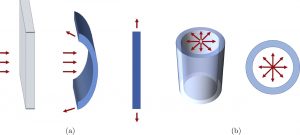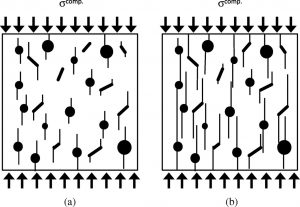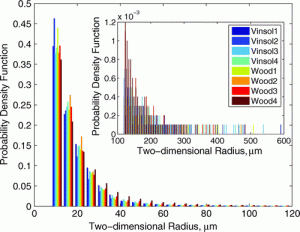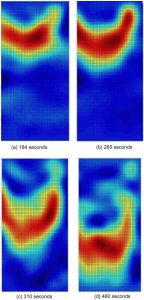Because of their inherent random inhomogeneities and brittle failure, models of cementitious materials present a significant modeling challenge. The Graham-Brady group has looked at two primary areas associated with these materials: 1) damage growth and fragmentation at high rates, and 2) localizations of stress and/or damage due to random inhomogeneous microstructure.
A micro-mechanical modeling approach for dynamic fragmentation in brittle multi-phase materialsUnderstanding the response of structures exposed to high rate mechanical loading is important for improved protection and security. Modeling the behavior of these structural materials and components can be performed at different scales. However, a detailed picture of the behavior of the material under high strain rates can only be gained by treating each of its components independently. In this work, we present a one-dimensional finite element model to study dynamic fragmentation in multi-phase materials, and we applied it to study masonry as an example of multi-phase material for structural applications. The model follows a micro-mechanical approach where the matrix (brick), inclusions (mortar), and interfaces between matrix and inclusions are represented separately. Within each constituent, the heterogeneity in the material is introduced through a critical strength distribution. A cohesive zone model has also been incorporated to model progressive damage. Results show the influence of the volume fraction and the inclusion size on the average fragment-size and fragment-size distributions for strain rates between 102and 105 s<span id=”MathJax-Element-1-Frame” class=”MathJax_SVG” style=”margin: 0px; padding: 0px; font-style: normal; font-weight: normal; line-height: normal; font-size: 16.200000762939453px; text-indent: 0px; text-align: left; text-transform: none; letter-spacing: normal; float: none; direction: ltr; max-width: none; max-height: none; min-width: 0px; min-height: 0px; border: 0px;” role=”presentation” data-mathml=”−1″>. Based on these results, a mathematical expression that captures the dependence of the average fragment-size on the strain rate, volume fraction and inclusion size has also been formulated. The observed increase on the average fragment-size with decreasing the inclusion size suggests the existence of a critical length that depends on the strain rate and material properties below which, no additional fragments of the inclusion-material are created. |
Cereceda, D., Kats, D., Daphalapurkar, N. & Graham-Brady, L. (2018). “A micro-mechanical modeling approach for dynamic fragmentation in brittle multi-phase materials,” International Journal of Solids & Structures, 134: 116-129. doi: 10.1016/j.ijsolstr.2017.10.026. |
Micromechanical Model and Associated Validation for Dynamic Failure of Brittle Materials Containing Pores and Slit-like FlawsCharacterizing dynamic failure is critically important to a number of applications, among others including armor, material fragmentation, and structural blast. In brittle materials, this failure is driven by crack growth from pre-existing flaws in the material microstructure. Structural scale models that explicitly address the cracks associated with each individual flaw are computationally infeasible; therefore, a model that accurately links flaw population to dynamic failure strength provides a much-needed connection between the microscale and macroscale. The current paper introduces a micromechanical model that addresses the effects of both air-entrained pores and slit-like flaws on the strain-rate dependent uniaxial compressive strength of the material. In particular, four variants of the model are addressed: a two-dimensional (2D) model with only pore flaws, a 2D model with both pores and slit-like flaws, a pseudo-three-dimensional (3D) model with only pore flaws, and a pseudo-3D model with both pores and slit-like flaws. To demonstrate the relative success of each of these approaches, the model is based on microstructural characterization and subsequent Kolsky bar tests on air-entrained mortar. Air-entrained mortar provides an excellent model material for this study, since the pore population introduced by air-entrainment is characterized relatively easily and the slit-like flaw population is deduced from the sand gradation. Furthermore, the sample sizes used in the Kolsky bar set-up are larger than the length scale of the microstructure of mortar, so that the samples are reasonably representative and provide a good basis of comparison with the micromechanics model. The micromechanics model is shown to provide reasonable agreement with experimentally obtained uniaxial compressive dynamic strength of air-entrained mortar. |
Graham-Brady, L.L., Katcoff, C.Z., Mayercsik, N.P. & Kurtis, K.E. (2015). “Micromechanical Model and Associated Validation for Dynamic Failure of Brittle Materials Containing Pores and Slit-like Flaws,” Journal of Engineering Mechanics, ASCE, 141(10): 04015040. |
Digital image correlation analysis of interfacial debonding properties and fracture behavior in concreteThe use of digital image correlation (DIC) as a fracture mechanics tool is described, for two projects currently underway. The goal of the first project is to examine the bond between carbon fiber reinforced polymers (CFRP) and concrete substrates. The second project involves the interfacial transition zone (ITZ) of plain concrete, and the softening and fracture behavior of this region. For both projects, DIC allows for precise measurement of the surface displacements of the deforming materials. The resulting strain data are higher in resolution than is possible with other experimental techniques. For both projects, the DIC results are being used to determine bond constitutive laws, which will be the basis for fracture mechanics studies of the materials. |
Corr, D.J., Accardi, M., Graham-Brady, L. & Shah, S. (2006). “Digital image correlation analysis of interfacial debonding properties and fracture behavior in concrete,” Engineering Fracture Mechanics, 74(1,2): 109-121. |
Other relevant publicationsSaouma, V., Hariri-Ardebili, M.A., Graham-Brady, L. (2020). “Stochastic Analysis of Concrete Dams with Alkali Aggregate Reaction,” Cement and Concrete Research, 132: 106032. Cereceda, D., Graham-Brady, L. & Daphalapurkar, N. (2017). “Modeling dynamic fragmentation of heterogeneous structural materials,” International Journal of Impact Engineering, 99:85-101. Mayercsik, N.P., Shaeffer, M., Graham-Brady, L.L. & Kurtis. K.E. (2015). “Analysis of Portland Cement mortar under impact: a combined materials characterization, micromechanics modeling, and dynamic testing approach,” Cement and Concrete Research, 73: 190-206. Katcoff, C.A. & Graham-Brady, L.L. (2014). “Modeling Dynamic Brittle Behavior of Materials with Circular Flaws or Pores,” International Journal of Solids & Structures, 51: 754-766. Tregger, N., Corr, D., Graham-Brady, L. & Shah, S. (2007). “Modeling mesoscale uncertainty for concrete in tension,” Computers & Concrete, 4: 347-362. Tregger, N., Corr, D., Graham-Brady, L. & Shah, S. (2006). “Modeling the effect of mesoscale randomness on concrete fracture,” Probabilistic Engineering Mechanics, 21(3): 217-225. |
|




